AMD A10-5800K & A8-5600K Review: Trinity on the Desktop, Part 1
by Anand Lal Shimpi on September 27, 2012 12:00 AM ESTAfter years of waiting, AMD finally unveiled its Llano APU platform fifteen months ago. The APU promise was a new world where CPUs and GPUs would live in harmony on a single, monolithic die. Delivering the best of two very different computing architectures would hopefully pave the way for a completely new class of applications. That future is still distant, but today we're at least at the point where you can pretty much take for granted that if you buy a modern CPU it's going to ship with a GPU attached to it.
Four months ago AMD took the wraps off of its new Trinity APU: a 32nm SoC with up to four Piledriver cores and a Cayman based GPU. Given AMD's new mobile-first focus, Trinity launched as a notebook platform. The desktop PC market is far from dead, just deprioritized. Today we have the first half of the Trinity desktop launch. Widespread APU availability won't be until next month, but AMD gave us the green light to begin sharing some details including GPU performance starting today.
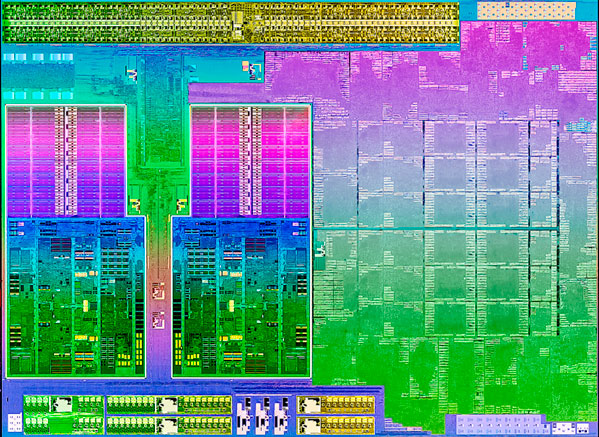
AMD's Trinity APU, 2 Piledriver modules (4 cores)
We've already gone over the Trinity APU architecture in our notebook post earlier this year. As a recap, Piledriver helped get Bulldozer's power consumption under control, while the Cayman GPU's VLIW4 architecture improved efficiency on the graphics side. Compared to Llano this is a fairly big departure with fairly different CPU and GPU architectures. Given that we're still talking about the same 32nm process node, there's not a huge amount of room for performance improvements without ballooning die area but through architecture changes and some more transistors AMD was able to deliver something distinctly faster.
| Trinity Physical Comparison | |||||
| Manufacturing Process | Die Size | Transistor Count | |||
| AMD Llano | 32nm | 228mm2 | 1.178B | ||
| AMD Trinity | 32nm | 246mm2 | 1.303B | ||
| Intel Sandy Bridge (4C) | 32nm | 216mm2 | 1.16B | ||
| Intel Ivy Bridge (4C) | 22nm | 160mm2 | 1.4B | ||
On the desktop Trinity gets the benefit of much higher TDPs and thus higher clock speeds. The full lineup, sans pricing, is below:
Remember the CPU cores we're counting here are integer cores, FP resources are shared between every two cores. Clock speeds are obviously higher compared to Llano, but Bulldozer/Piledriver did see some IPC regression compared to the earlier core design. You'll notice a decrease in GPU cores compared to Llano as well (384 vs. 400 for the top end part), but core efficiency should be much higher in Trinity.
Again AMD isn't talking pricing today, other than to say that it expects Trinity APUs to be priced similarly to Intel's Core i3 parts. Looking at Intel's price list that gives AMD a range of up to $134. We'll find out more on October 2nd, but for now the specs will have to be enough.
Socket-FM2 & A85X Chipset
The desktop Trinity APUs plug into a new socket: FM2. To reassure early adopters of Llano's Socket-FM1 that they won't get burned again, AMD is committing to one more generation beyond Trinity for the FM2 platform.
The FM2 socket itself is very similar to FM1, but keyed differently so there's no danger of embarrassingly plugging a Llano into your new FM2 motherboard.
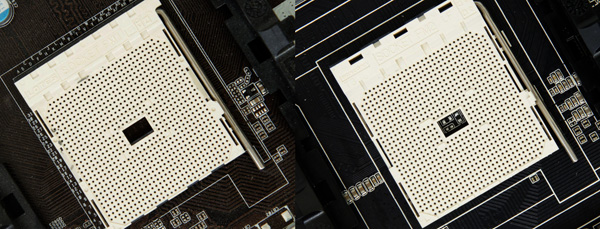
Socket-FM1 (left) vs. Socket-FM2 (Right)
AMD both borrows from Llano as well as expands when it comes to FM2 chipset support. The A55 and A75 chipsets make another appearance here on new FM2 motherboards, but they're joined by a new high-end option: the A85X chipset.
The big differentiators are the number of 6Gbps SATA and USB 3.0 ports. On the A85X you also get the ability to support two discrete AMD GPUs in CrossFire although obviously there's a fairly competent GPU on the Trinity APU die itself.
The Terms of Engagement
As I mentioned earlier, AMD is letting us go live with some Trinity data earlier than its official launch. The only stipulation? Today's preview can only focus on GPU performance. We can't talk about pricing, overclocking and aren't allowed to show any x86 CPU performance either. Obviously x86 CPU performance hasn't been a major focus of AMD's as of late, it's understandable that AMD would want to put its best foot forward for these early previews. Internally AMD is also concerned that that any advantages it may have in the GPU department are overshadowed by their x86 story. AMD's recent re-hire of Jim Keller was designed to help address the company's long-term CPU roadmap, however until then AMD is still in the difficult position of trying to sell a great GPU attached to a bunch of CPU cores that don't land at the top of the x86 performance charts.
It's a bold move by AMD, to tie a partial NDA to only representing certain results. We've seen embargoes like this in the past, allowing only a subset of tests to be used in a preview. AMD had no influence on what specifics benchmarks we chose, just that we limit the first part of our review to looking at the GPU alone. Honestly with some of the other stuff we're working on I don't mind so much as I wouldn't be able to have a full review ready for you today anyway. Our hands are tied, so what we've got here is the first part of a two part look at the desktop Trinity APU. If you want to get some idea of Trinity CPU performance feel free to check out our review of the notebook APU. You won't get a perfect idea of how Piledriver does against Ivy Bridge on the desktop, but you'll have some clue. From my perspective, Piledriver seemed more about getting power under control - Steamroller on the other hand appears to address more on the performance side.
We'll get to the rest of the story on October 2nd, but until then we're left with the not insignificant task of analyzing the performance of the graphics side of AMD's Trinity APU on the desktop.
The Motherboard
AMD sent over a Gigabyte GA-F2A85X-UP4 motherboard along with an A10-5800K and A8-5600K. The board worked flawlessly in our testing, and it also gave us access to AMD's new memory profiles. A while ago AMD partnered up with Patriot to bring AMD branded memory to market. AMD's Performance line of memory includes support for AMD's memory profiles, which lets you automatically set frequency, voltage and timings with a single BIOS setting.
We've always done these processor graphics performance comparisons using DDR3-1866, so there's no difference for this review. The only change is we only had to set a single option to configure the platform for stable 1866MHz operation.
Processor graphics performance scales really well with additional memory bandwidth, making this an obvious fit. There's nothing new about memory profiles, this is just something new for AMD's APU platform.


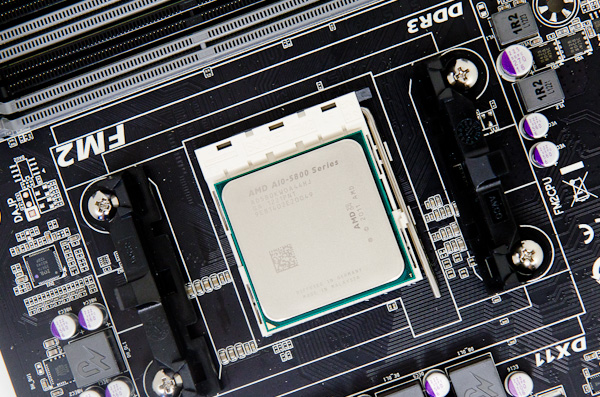
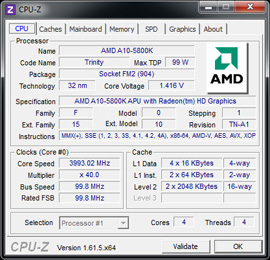
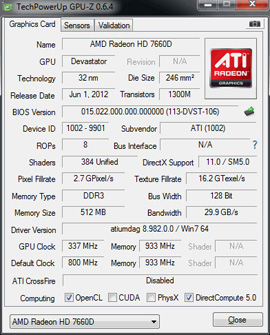
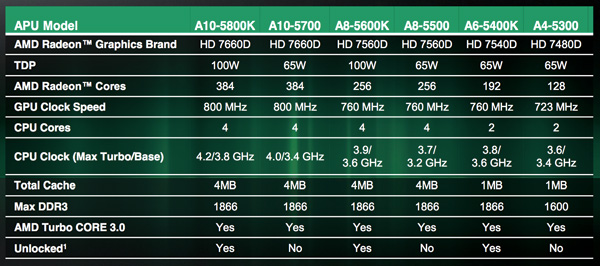

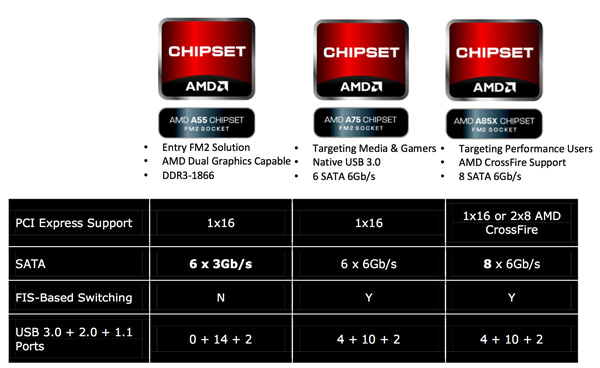






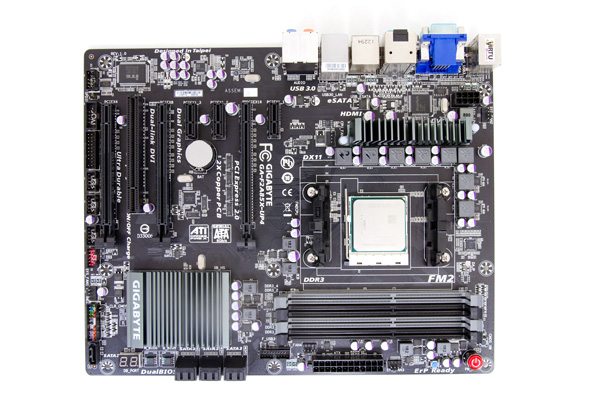

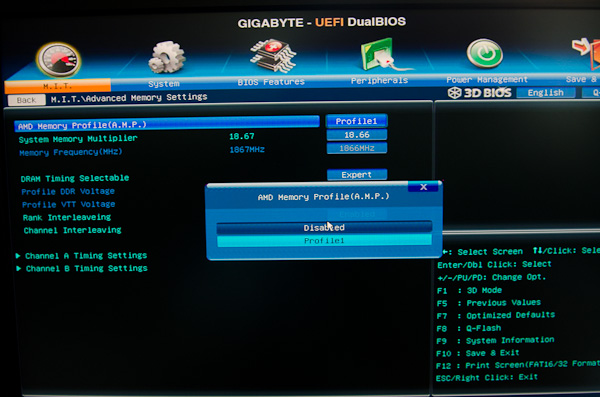








139 Comments
View All Comments
parkerm35 - Monday, October 1, 2012 - link
First of all you have never owned a 3870k, as your just an Intel fan boy wanting some attention. The simple fact is you have chosen to look for an AMD review to feed us this rubbish, this just shows how obssesed you are. If you don't like AMD parts, that's fine, but it's because of people like you why AMD is in this kind of mess to start of with. I bet your one of these people who went out and bought a P4 as well?This review has just shown you this APU competing with discrete graphics cards, and doing a damn good job at it too. How much was your G620? add the price of a discrete card that is capable of matching the trinity, maybe looking at a GT630 (which i think will be slightly slower), $70? + $65 for the CPU $135 for a dual core, slower CPU and in all a more power hungry setup. Do me a favor.
" A G620 can compete generally with a 3870K on the CPU side. That is just embarrassing. The 5800K isn't much of an improvement."
How do you know the 5800k isn't much of an improvement? This hole review is about GPUs, no CPU data what so ever.
Could you please list these HD1000 parts with quicksync.
kpo6969 - Thursday, September 27, 2012 - link
Anand if you went along with this your stock as one of (if not the best) reviews to trust site has gone way down. Just my opinion.rhx123 - Thursday, September 27, 2012 - link
I agree. They should have done the same as TechReport and called AMD out on this.I have been a long time lurker, and I nearly posted about Anandtech's spin on the Enduro Update, but now it really feels like there's something going on between the two.
It's obvious that in making AMD hold this information back, it's confirmed to everyone in the know that piledriver is going to be rubbish , and has probably done AMD more damage than just letting people release the benchmarks.
Just hoping a Chinese reviewer somewhere can get his hands on the parts and release some real CPU benchmarks.
jaydee - Thursday, September 27, 2012 - link
Fortuanately, Anand has more class than to be a blatant hypocrite like "Tech Report" in happily preview Intels chips under certain parameters, but complaining about it when AMD does it.http://techreport.com/review/9538/intel-conroe-per...
cobalt42 - Thursday, September 27, 2012 - link
You're simply pointing out the difference between a PRE-view and a RE-view, not pointing out any supposed hypocrisy.A preview is often done on the manufacturer's terms. Compare to what is often done in gaming; you get to see what they show you, and you're careful not to draw conclusions. (To quote TR's conclusions in that article you cite, they start with "Clearly, it's way too early to call this race.") Previews are also often done when you're offsite and in their controlled conditions. Plus, the article you write about it is called a "preview" in the title, not a "review". Look at the title of these articles versus the one you cite.
What AMD is trying to do here is control the output of REviews.
Visual - Thursday, September 27, 2012 - link
The high-end GPU version seems nice, its disappointing there are weaker versions though. Especially the mobile version, with not nearly enough performance to distinguish itself from the intel offering.Jamahl - Thursday, September 27, 2012 - link
Can you point out that the GT 640 in this review is in an Ivy bridge powered system? It would have been nice to have it running in the 5800K system, just to see how close the graphics portion of Trinity really is to it.Rick83 - Thursday, September 27, 2012 - link
"Note that this test fails on all Intel processor graphics, so the results below only include AMD APUs and discrete GPUs."Well, down to the i5's they all have AES acceleration in the CPU pipeline.
Would be interesting to see a direct comparison of that to the results in the table.
Of course, for the i3s and below, this is a bit of a let-down.
DanNeely - Thursday, September 27, 2012 - link
What's with the pair of USB1 ports that AMD still puts on all their chipsets?jasomill - Thursday, September 27, 2012 - link
A cost-saving measure, perhaps, intended for use with integrated devices? Many devices don't benefit from speeds in excess of 12Mbps: keyboards, pointing devices, digitizer tablets, Bluetooth adapters, infrared ports, fingerprint readers, GPS receivers, accelerometers, ambient light sensors, switches, buttons, blinkenlights, fax modems, floppy drives, . . .